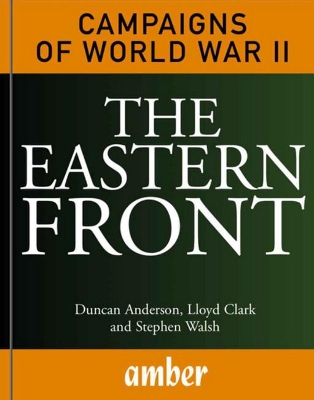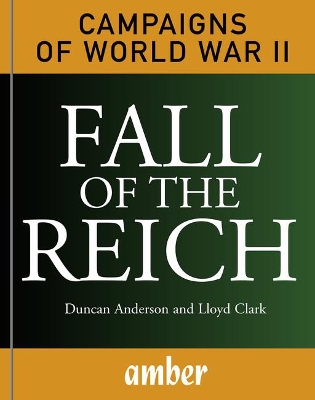Campaigns of World War II
2 total works
The conflict on the Eastern Front in World War II was colossal in both scale and intensity, as the two infamous dictators of the twentieth century - Adolf Hitler and Josef Stalin - vied for supremacy in Eastern Europe. On 22 June 1941 it was Hitler's fateful decision to launch the largest invasion ever seen, Operation Barbarossa, when 138 German divisions attacked the Soviet Union. Four years later, some two million German and eleven million Russian soldiers had ben killed in the course of their struggle, and names like Stalingrad and Kursk had been burnt into the world's consciousness. The Eastern Front is a detailed account of this epic clash, the greatest continuous land battle in history. The book explores in detail the state of the German and Soviet armies in 1941, and the planning and preparation of both sides for the German attack. Campaigns covered include Operation Barbarossa, the rapid German advance on Moscow and the first Soviet winter offensive in 1941-42. The race for the Caucasian oilfields in Operation Blue, as the 1942 German campaign was known, is also described, as is the fight for Stalingrad and the infamous destruction of the German Sixth Army, the Soviet success in early 1943, and the resultant German counter at Kharkov. The book details Hitler's last major offensive in the summer of 1943 that led to the world's largest tank battle at Kursk, and the significant Soviet victories that followed, with Operation Bagration in 1944 capturing huge numbers of German prisoners. Finally, the book looks at the Soviet advance onto German soil, the capture of Berlin itself and the subsequent suicide of Adolf Hitler as shells rained on his bunker. Written by three leading military historians, the Eastern Front is a superb history of the cataclysmic struggle between Nazi Germany and the Soviet Union.
Campaigns of World War II: Fall of the Reich is a military history of the Western European campaign from D-Day in June 1944 to the fall of Berlin in May 1945. Beginning with the Allied preparations for what would become Operation Overlord, from the initial discussions of Roosevelt and Churchill, to the deliberations and plans of Marshall and Brooke, and the subsequent appointment of commanders like Eisenhower, Montgomery and Ramsay, the book covers in detail the landings on the Normandy coast. Combining tactical coverage of events such as the severe fighting at Omaha and Pegasus Bridge, the Canadian success on Juno beach, and the 21st Panzer Division's aborted counterattack, with reporting of the reactions of Hitler and Rommel to the landings, the book provides an explanation of why the Allied advance ran out of steam, and a description of their struggle to escape the bocage hedgerows of Normandy.
The US-led breakout in late July 1944 released Bradley and Patton's forces into the heart of France, and the liberation of Paris followed swiftly. A crumbling German defence led to Allied overconfidence and the resultant 'bridge too far' at Arnhem, but as the Allies approached the Rhine and the German border, resistance quickly stiffened. Hitler's last gamble, the attack through the Ardennes known as the Battle of the Bulge, brought temporary panic to the Allied ranks, but heroic stands at Bastogne and elsewhere, coupled with a German acute lack of petrol and the weather clearing to allow Allied aircraft to operate again, led to the defeat of the last Wehrmacht attack in the west. The final year of the war saw the Allies advancing as occupying forces into the heart of Germany, adopting Eisenhower's broad front strategy. Finally the book examines why the decision was made to allow the Red Army to occupy Berlin and remain on the western bank of the Elbe river.
Part of a five-volume series on the Second World War written by prominent military historians, Fall of the Reich is a masterful account of the 1944-45 campaign in Western Europe that describes both the action on the front line and the decisions made behind the scenes that decided the fate of Nazi Germany.
The US-led breakout in late July 1944 released Bradley and Patton's forces into the heart of France, and the liberation of Paris followed swiftly. A crumbling German defence led to Allied overconfidence and the resultant 'bridge too far' at Arnhem, but as the Allies approached the Rhine and the German border, resistance quickly stiffened. Hitler's last gamble, the attack through the Ardennes known as the Battle of the Bulge, brought temporary panic to the Allied ranks, but heroic stands at Bastogne and elsewhere, coupled with a German acute lack of petrol and the weather clearing to allow Allied aircraft to operate again, led to the defeat of the last Wehrmacht attack in the west. The final year of the war saw the Allies advancing as occupying forces into the heart of Germany, adopting Eisenhower's broad front strategy. Finally the book examines why the decision was made to allow the Red Army to occupy Berlin and remain on the western bank of the Elbe river.
Part of a five-volume series on the Second World War written by prominent military historians, Fall of the Reich is a masterful account of the 1944-45 campaign in Western Europe that describes both the action on the front line and the decisions made behind the scenes that decided the fate of Nazi Germany.

